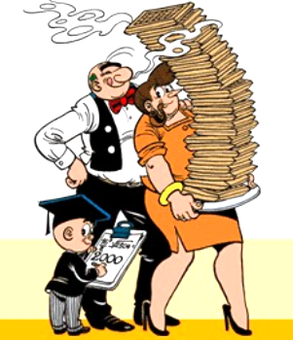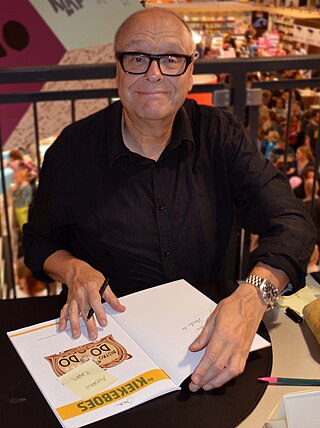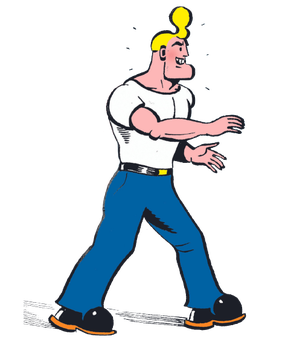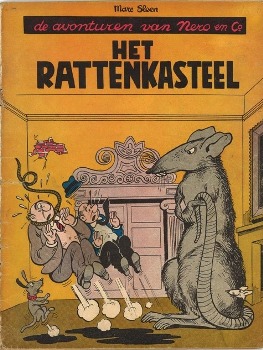Background and concept
The strip originated from an idea by Willy Linthout. [4] In 1982, Linthout imagined creating a comic strip about comedian Urbanus. [4] Publisher Jef Meert was able to arrange a meeting at his house, in which he proposed the concept and showed Urbanus the drawings. [4] [5] Urbanus liked Linthout's idea and his drawings. [5] Urbanus started as an experiment, but after the first album was released, Linthout was already working on the sequel. [5] Linthout made the first two albums alone. [5] The first album sold 50,000 copies right away. [5] From December 16, 1982, until April 25, 1996, all albums were published by Uitgeverij Loempia, [3] a publishing company created by Linthout and Jef Meert. Since 1996 Standaard Uitgeverij does the publishing.
Linthout and Urbanus explained how a comic book of Urbanus was made: Linthout came up with an idea, wrote the synopsis, and submitted it to Urbanus. Then, the two started writing together, and eventually Linthout drew the comic book. [5]
In the series Urbanus is portrayed as an eleven to twelve-year old version of himself, despite his full-grown beard. Just like the real Urbanus he lives in Tollembeek, but here end all similarities. Urbanus is portrayed as a bad young boy who frequently tries to trick the local villagers, his parents, his teacher, his fellow students and gets into trouble for it. [6] The style of comedy is absurd, black and often vulgar. All animals in this comic strip are able to talk. Pop culture references to TV shows, comics, cartoons, films and Urbanus' own merchandise are frequently made. The authors deliberately use Flemish dialect instead of standard Dutch and also deliberately keep the drawing style naïve and simple, inspired by the series of Marc Sleen.
The albums are usually long adventure stories, but some are one-page gags as well.
On 26 October 2022, after 201 stories, the series was discontinued. [7]

The Adventures of Nero or Nero was a Belgian comic strip drawn by Marc Sleen and the name of its main character. The original title ranged from De Avonturen van Detectief Van Zwam in 1947 to De Avonturen van Nero en zijn Hoed in 1950, and finally De Avonturen van Nero & Co from 1951. It ran in continuous syndication until 2002. From 1947 until 1993 it was all drawn by Sleen himself. From 1992 until 2002 Dirk Stallaert took over the drawing while Sleen kept inventing the stories.

Spike and Suzy, Willy and Wanda or Luke and Lucy is a Belgian comics series created by the comics author Willy Vandersteen.

Marcel Honoree Nestor (ridder) Neels, known as Marc Sleen, was a Belgian comics artist. He was mostly known for his humorous adventure comic The Adventures of Nero and Co., but also created gag comics like Piet Fluwijn en Bolleke, De Lustige Kapoentjes, Doris Dobbel, Oktaaf Keunink and De Ronde van Frankrijk.

Willebrord Jan Frans Maria "Willy" Vandersteen was a Belgian creator of comic books. In a career spanning 50 years, he created a large studio and published more than 1,000 comic albums in over 25 series, selling more than 200 million copies worldwide.

Urbain Servranckx, better known as Urbanus, is a Belgian comedian, actor, singer and comic book writer. Although he is most famous as comedian, some of his songs became hits, such as Bakske vol met stro (1979), Madammen met een bontjas (1980) and Hittentit (1982). He is one of the most popular and famous entertainers in Flanders and the Netherlands.

Jommeke is a Belgian comic strip series in publication since 1955. It was created by Jef Nys and can be defined as a humoristic children's adventure series. Jommeke, an 11-year-old boy, is the series' main protagonist. It was originally published in Kerk en Leven, before moving to Het Volk, where it ran until the newspaper ceased to exist in 2010. It is now published in Het Nieuwsblad, De Gentenaar and De Standaard.

Belgian comics are a distinct subgroup in the comics history, and played a major role in the development of European comics, alongside France with whom they share a long common history. While the comics in the two major language groups and regions of Belgium each have clearly distinct characteristics, they are constantly influencing one another, and meeting each other in Brussels and in the bilingual publication tradition of the major editors. As one of the few arts where Belgium has had an international and enduring impact in the 20th century, comics are known to be "an integral part of Belgian culture".

Jozef "Jef" Nys was a Belgian comic book creator. He was best known for his comic strip Jommeke.
The Bronzen Adhemar is the official Flemish Community Cultural Prize for Comics, given to a Flemish comics author for his body of work. It is awarded by the Flemish Ministry of Culture during Strip Turnhout, the major Flemish comics festival, once every two years.
Tom Bouden is an openly gay Belgian artist, best known for his comics albums, which often satirize old-fashioned Belgian comics.

Merho, is a Belgian comic-book writer and artist, best known for creating the comic strip De Kiekeboes.

Willy Linthout is a Belgian comics author, best known for the Urbanus comics and his graphic novel Years of the Elephant.

Cowboy Henk is a Belgian absurd/surreal humour gag-a-day comic strip series drawn by Herr Seele and written by Kamagurka. It was originally published in the newspaper De Morgen, but later taken over by the magazine HUMO, in which it is still published today and for whom Henk is now their mascot. The series was in continuous syndication from 1981 until 2011. After the brief interruption it was continued again in the spring of 2013.

Piet Fluwijn en Bolleke was a Belgian gag-a-day comic strip series drawn by Marc Sleen from 1944 until 1965. It was continued by artists Hurey and Jean-Pol until 1974.
't Kapoentje was a youth supplement published by the Flemish newspaper Het Volk from April 3, 1947 until 1989. It was notable for its comics and, together with Ons Volkske, the most important comic book magazine in Flanders.

De Lustige Kapoentjes was a long-running Flemish comic book series, which existed under different titles and was drawn by different artists, among whom Marc Sleen and Willy Vandersteen are the most well known. The series was published in 't Kapoentje, the youth supplement of Het Volk, and in Ons Volkske, the youth supplement of De Standaard. They were the mascots of 't Kapoentje from 1947 until the magazine's demise in 1985.

Suske en Wiske Weekblad was a Belgian comics magazine which debuted in September 15, 1993 and ran in weekly syndication until December 24, 2003. It was based on the popularity of Suske en Wiske and notable for being the last attempt in Flanders to release a new comic book magazine.
Bert is a Belgian comic strip, written and drawn by Kamagurka, which appeared exclusively in the Flemish magazine HUMO since 1977. The cartoons have also been published in the Dutch magazine Vrij Nederland, the French magazine Charlie Hebdo and the US magazine RAW. The series' protagonist, Bert, is Kamagurka's most recognizable character.

Het Rattenkasteel is a 1948 comic book album in the Belgian comics series The Adventures of Nero by Marc Sleen. It's the fourth album in the series and acclaimed as one of Sleen's best. In the 2000s the story was collected and re-published by the Flemish newspapers Het Belang van Limburg and Gazet van Antwerpen in a special series entitled "De beste 10 volgens Marc Sleen", where Sleen choose his ten favorite "Nero" stories. He placed "Het Rattenkasteel" first.

Years of the Elephant is a Flemish graphic novel by Willy Linthout. Linthout was awarded the 2009 Bronzen Adhemar for this work.

















